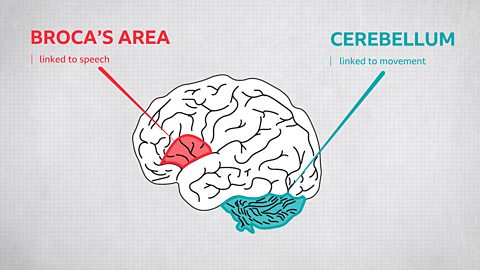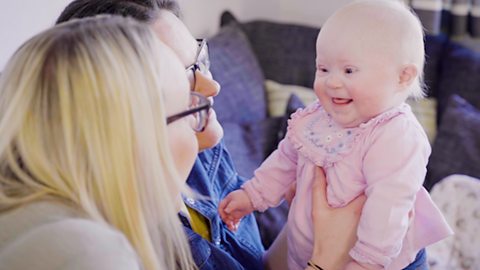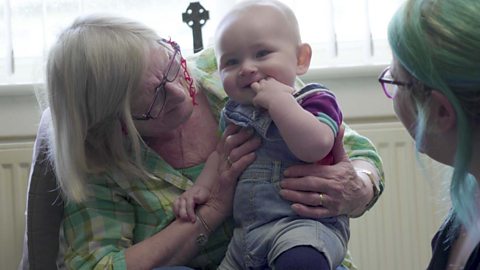Babies make all kinds of funny sounds and noises. Cries, laughs, gurgles but did you know not all of their sounds are created equal?
When babies babble, they're trying out some of the sounds they will later be able to use to make words. And this is a really important stage of their language development.
We tested out whether there is a way you can actually get your baby to babble more, and the science behind it in our speech lab.
Check out the results of of this amazing baby babble experiment with Professor Ben Ambridge in the video below.
Babies make all kinds of funny sounds and noises. Cries, laughs, gurgles but did you know not all of their sounds are created equal? When babies are babbling they're actually having their first go at talking and are practising the speech sounds that they'll need when they start saying their first words. So babbling is really important but is there a way you can get your baby to do more of it?
How old's Herbie?
Laura
He's just over seven months.
Ben
Great, so is he just about starting to babble?
Laura
Yeah, a little bits here and there he definitely likes communicating with us.
Ben
Brilliant. So today we're going to see if we can get him to babble even more and see why that's so important for language development. So what we're listening out for is those classic babble sounds like 'ga-ga-ga' or 'da-da-da'. We'll count the number of babbles that Herbie does in two minutes, when you stay quiet.
So Herbie did babble once but then he stopped when he didn't hear anything back from you. Now let's see what happens when you respond quickly to Herbie's babble, by talking or babbling back.
Laura
Ga-ga-ga-ga-ga. Can you say ga-ga-ga-ga-ga? Ba-ba-ba-ba-ba .
That's it!
łŇ˛ą-˛µ˛ą-˛µ˛ąâ€¦
Ben
So during that two minutes when you were responding and babbling back to Herbie we got three babbles in the two-minute period and that's compared to once when you weren't responding to him. So once Herbie starts babbling talking and babbling back to him isa really great way to keep him going. Studies show, that when babies hear speech parts of the brain that control mouth movement become activated- even before they can talk! This shows that their little brains are practising how to speak, just by listening to you. So babies are learning to link together the noises and the shapes that your mouth makes when you speak. So when they babble, respond quickly and talk and babble back. You can help your baby learn and practise the sounds that go on to form words.
Try the baby babble experiment at home
Want to find out whether you can make your baby babble more often? Our Speech Lab experiment is a really simple way to see the science of responding to baby babble in action at home.
When you're doing this experiment, you want to be listening out for any classic babble sounds like 'ga-ga-ga' or 'da-da-da'.
Start off by staying quiet for two minutes and counting the number of babbles your baby does on their own in this time.
Next, see what happens when you respond quickly to your baby's babble, by talking or babbling back. Count the babbles this time. What is the difference?
When we tried this experiment in our speech lab, we noticed a 200% increase in the number of babbles when our family babbled back to their baby.
Do you notice a similar increase when you do it at home?

What happens in a baby's brain when you babble back?
Studies show when babies hear speech parts of the brain that control mouth movement become activated. This happens even before they can talk!
This shows us their brains are practising how to speak, just by listening to you.
When you babble back to them, babies are learning to link together the noises and the shapes your mouth makes when you speak.
This is why it's so important to respond quickly, talk and babble back to your baby. You can help your baby learn and practise the sounds that go on to form words.
How to encourage your baby to babble
We have lots of different activities around our website that will help encourage your baby to start babbling. We've listed a few below:
- Talking about your day and narrating what you're doing is a great way to introduce more words to your baby.
- A simple game of copy cat lets your child know that they're listened to and you're ready to communicate with them.
- Singing and repeating rhymes helps baby discover the rhythm of language.
- Face-to-face chat and play is a great way for babies to start to learn from birth.







